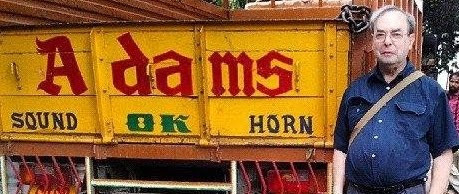An Albanian in Cochin
Fort Cochin ('Kochi' in Malayalam) lies near the mouth of a saline lagoon on the Malabar Coast in Kerala on the western side of India. Every 2 years it hosts the Kochi-Muziris Biennale. The brainchild of the artist Bose Krishnamachari, this exhibition of art by leading Indian and international contemporary artists makes use of the fabulous interiors of Kochi's magnificent heritage buildings to display the exhibits. The largest venue, which contains the majority of the works is Aspinwall House, the former headquarters of a British trading firm.
This year (2014) the artists include, in addition to leading Indian artists, such well-known names as: Anish Kapoor, Mona Hatoum, Yoko Ono, and William Kentridge. Amongst the best works on show is a video by the Albanian born artist Adrian PACI.
Paci was born in the Albanian city of Shkoder (Scutari) in 1969. He studied in Tirana along with the artist Edi Rama, who is currently Albania's prime minister. In the 1990s, Paci moved to Italy. He now lives and works in Milan. He was aged 22 when Albania's hard-line, isolationist, Stalinist regime suddenly crumbled in the very early 1990s. Therefore, he lived throughout his childhood and early adulthood under the repressive conditions imposed firts by Albania's dictator Enver Hoxha, and then by his successor Ramiz Alia. I felt that the influence of his experiences of those times are to some extent expressed in his video The Column.
Paci's video lasts about 25 minutes. It begins in a marble quarry in China. A large piece of marble is being hewn carefully from the bed-rock. The ne4xt scene begins with shots of cranes at a dock side. The rectanguloid piece of marble form the quarry is carefully lowered into the hold of a long ocean-going freighter vessel. This boat sets off for Europe from China. Throughout the voyage, a small team of Chinese sculptors meticulously transform the lump of stone into a classical column with an elaborately decorative capital. Paci's film captures details of this process: the actual carving as well as the expressions on the sculptors' faces. The sculptors' teamwork and dedication to the task is well portrayed. In addition, Paci focusses on details of the ship, the sea, and the men's activities such as cooking, relaxing, and smoking. For example, Paci shows us a sculptor popping a piece of gum into his mouth whilst smoking a squashed cigarette. In anothe short sequence, we see a man chopping cabbage in prepariation for a meal. This is inserted between scenes showing the men cutting the marble. Features such as these in addition to shots of the battered ship's hull and water rushing past the ship's exterior heighten the excitement of this visually intriguing film. Paci captures the textures of human activity and also of inanimate objects both beautifully and most sensitively. This film is far more than a documentary; it is a moving work of art. There is no soundtrack apart from the actual sounds of the men working and their surroundings.
Eventually, the column is finished. The hold of the freighter, which has up to now been open to the sky, is closed with slatted metal shutters. The final scene of the film shows lines of light that have filtered through gaps and holes in the shutters moving slowly along the the somewhat 'kitschy' but perfectly made column and its capital.
Paci's film , which I considered to be little short of perfect, made me reflect on its possible relationships with his native land Albania.
The film, The Column, is interesting as a work of art not only because it is in itself a brilliant creation but also because it follows the creation of a work of art, the column and its capital. The film portrays a heroic struggle between man (the sculptors) and nature (the stone block). Such heroic struggles bring to my mind the image that the former Stalist Communist regime of Albania used to enjoy portraying: little Albania, like David, versus the rest of the world, Goliath.
Paci would have been a small child when Albania broke with its ally the Peoples' Republic of China in the early 1970s. While I watched his film, I was impressed by the intense concentration and single-mindedness of the Chines sculptors. I was reminded of Ismail Kadare's novel The Concert in which the story of Albania's fracture with China unfolds. I wondered whether Paci would have herad about the unusual single-mindedness of the Chines who had helped to develop his native land. Did this, by any chance, affect his portrayal of the Chines sculptors?
The project itself - the carving of a rather ridiculous column at sea - amused me. I realise that it must have been a commission and could see the practicality of carving the stone while it was in transit, but nevertheless it intrigued me. Surrounded by the empty ocean without anything but the empty horizon to be seen, the monolithic project being executed by heroic and intensely serious workers represente, for me atleast, a metaphor of the Albania of Enver Hoxha - the metaphor of a self-sufficient state attempting live and function in complete isolation from the rest of the world.
I am very pleased that I had the chance to view Paci's visually engrossing and entirely fascinating work several times over and in such a pleasant environment as is afforded by the Kochi-Muziris Biennale, which will be reincarnated next in December 2016.
Now visit Adam YAMEY's
website:








